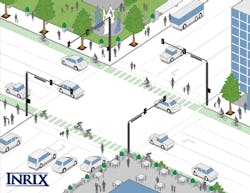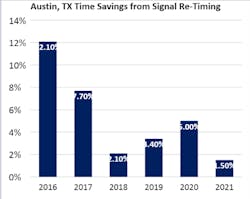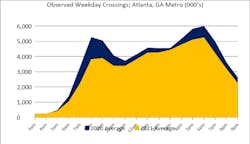Better traffic signals save time ... and can help save the planet
In February 2021, the United States officially rejoined The Paris Agreement, an international treaty on climate change, committing to reducing greenhouse gases (GHGs) by 50% below 2005 levels over the next decade. To meet these targets, the country needs to continue to reduce emissions 5% every year through 2030.
While overall emissions have decreased 12% since 2005, the U.S. is well behind its target goal largely due to the transportation sector, which has seen a 5% increase of GHGs due to its heavy reliance on fossil fuels. To put the climate targets in perspective, the U.S. needs to reduce GHGs by 5% per year, every year to meet its commitments—while total emissions have dropped just 12% over the last 15 years, an annual drop of just 0.9%.
These grim statistics have led to increasing calls to modernize, upgrade, and transform transportation infrastructure and operations.
While significant reductions in GHGs from energy generation have occurred as coal plants continue to be replaced, significant large-scale reductions in the transportation sector have yet to occur. On a worldwide scale, transportation-sector GHGs continue to be the fastest-growing source of global carbon emissions.
Much of the focus has been smart growth policies, expanding the electric fleet, building of urban rail transit, and reducing vehicle-miles traveled. While those strategies have played a role in reducing GHGs and attempt to take large bites out of carbon emissions, opportunities are growing to make smaller, higher benefit-cost investments to make a difference.
Traffic signal optimization often bubbles to the top of the list of high benefit-cost projects. Retiming traffic lights to minimize traffic delays also improves traffic safety and the environment, saving drivers and freight movers time and money and improving a city’s quality of life. In addition, these improvements can start bringing benefits immediately, not decades down the line inherent in large capital infrastructure projects.
More people are staring at traffic lights—yet some cities fight back
As vehicles approach an intersection, they must either stop or proceed. When vehicles stop, queuing and idling begins. Idling burns fuel unproductively and expels GHGs and particulates matter into the atmosphere. Acceleration from the stop also increases emissions, as two-ton vehicles take substantial amounts of energy to propel to driving speeds. Ultimately, if vehicles are having to stop unnecessarily due to poor or incorrect signal timing, carbon emissions needlessly increase.
In 2004, the Federal Highway Administration estimated that 5% of total delays were due to waiting at traffic signals. Yet, the INRIX Signals Scorecard, based on data from 210,000 traffic signals across the U.S., revealed 10% of total trip time is due to delay, backing up recent industry research that upwards of 25% of delay is spent sitting at traffic lights. This means that traffic delays at intersections are up to five times worse than previously estimated, and as urbanization and densification continues, this is expected to grow. To mitigate the increase in vehicular delays, agencies across the world are turning to monitoring and optimizing their traffic signals.
Los Angeles was one of the first U.S. cities to implement network-wide signal synchronization. Signals are either pre-timed, adaptive, or actuated and work together to maximize traffic throughput and bike/ped/transit operations. Before-and-after studies in Los Angeles found that drivers saved 12% on travel times due to signal upgrades and operations. Another L.A. study found travel times decreased more than 30%, leading to a 3-4% reduction in vehicular emissions.
The city of Austin, Texas, has experienced rapid growth over the last two decades. To mitigate the increase in congestion, city officials have continually improved the traffic signal network with significant success.
Every year, city officials establish performance goals for the city’s traffic signal network and signals are identified for improvement.
Since 2016, the city has monitored and updated the public with the most recent data regarding their signal efforts. The first two years, expectedly, were wildly successful. Travel times improved more than 12% in 2016, the first year of the program. The following year, travel times decreased nearly 8%. While following years have seen less of an improvement, the program is considered a success story—especially considering the rapid levels of population and employment growth enjoyed in the capital of Texas.
Other cities have followed suit. In Bellevue, Washington, travel speeds on key corridors—like the NE 8th St. arterial—improved 35-43% the first year of implementation. Streamlined left turns saved 166,000 hours of delays in 2014. In Kansas City, Missouri, the Mid-America Regional Council estimates a 37 to 1 benefit-cost ratio for signal timing. One major corridor saw a 54% reduction in travel delay during the PM peak due to coordination, leading to an 8-13% reduction in emissions.
These results should inspire transportation agencies of all sizes to dig deeper into traffic signal optimization—not just for traffic management, but the environment as well.
Can we achieve “flatter peaks?”
The INRIX Signals Scorecard revealed a major shift in travel patterns during the COVID-19 pandemic that transportation agencies may want to sustain. One goal of transportation officials has been to reduce the peak impact of traffic on the transportation network—by encouraging telecommuting, transit use, active transportation modes, and other Transportation Demand Management strategies. Though many factors led to decreases in vehicle volumes, COVID-19 revealed that many urban areas can more heavily rely on telecommuting to reduce the peak commute periods, especially the morning peak.
In Atlanta, INRIX observed a 23% drop in volumes during the AM peak period, versus 6% and 11% reductions in the midday and afternoon peak periods, respectively. This drop in volumes led to a 42% decrease in carbon emissions due to delay during the AM peak alone, saving 27,600 tons of CO2e over the course of a year at traffic signals. To put this in perspective, this three-hour period was responsible for nearly half of the emissions savings found throughout the 24-hour period.
Managing traffic includes distributing volumes in addition to delays. By utilizing network-wide traffic signal monitoring and optimization, traffic can be better spread throughout the transportation network, reducing strain on the hardest-working intersections. A cloud-based, system-wide approach allows users to monitor the impact of signal timing across the entire network.
Traffic signal optimization is more than just changing signal cycles to move a few cars. It is a system-wide approach to a better quality of life, fewer emissions, and the key to managing traffic networks moving forward.



